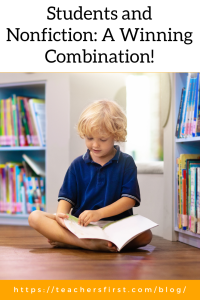Nonfiction reading has something for everyone! Even your most reluctant readers will find a nonfiction book about a topic they are interested in. Reading nonfiction can help students learn about and make connections to their world and history, think critically about topics, learn new vocabulary, increase comprehension, motivate further reading about their own interests, and can support inquiry! In addition, nonfiction reading promotes lifelong learning. Knowledge empowers!
How do you motivate students to read nonfiction? Set up a nonfiction “book tasting” with your school librarian. Students will not only learn about new nonfiction books, but will also get to see what’s available in the school library. You can also try giving nonfiction book talks. Book talks have been used for years to interest students in books. Make nonfiction book talks yourself or have your students make their own! Engage students in reading about current events or nonfiction online articles, then challenge them to find a nonfiction book to read that is related to the topic. Students love graphic novels, so engage them with nonfiction graphic novels! You can slo build connections between fiction and nonfiction. When you read a fiction book in class, show or make a list of nonfiction books that connect with the fiction book. Nonfiction picture books appeal to younger and older students alike. Have students read nonfiction picture books and then find primary sources that relate to the book’s topic. Share nonfiction book lists with students and allow them to choose nonfiction books with topics that appeal to their personal interests.
There are many classroom activities related to nonfiction books. As evidenced by the video above, nonfiction books have different text features than fiction books. Teach younger students about the anatomy of nonfiction books and nonfiction reading strategies. Older students will also benefit from learning these strategies and refreshing their learning about the anatomy of nonfiction books. Keep students engaged in ongoing nonfiction reading with activities like fun facts days, nonfiction reading responses, and other fun activities.
Nonfiction reading can be engaging and fun! As always, check out TeachersFirst for nonfiction resources and the TeachersFirst blog for related posts that feature other ways to use nonfiction in your classroom. Motivate your students to read nonfiction today!



I find more and more students choosing nonfiction over fiction. I like the idea of pairing nonfiction books with fiction books that include the topic.